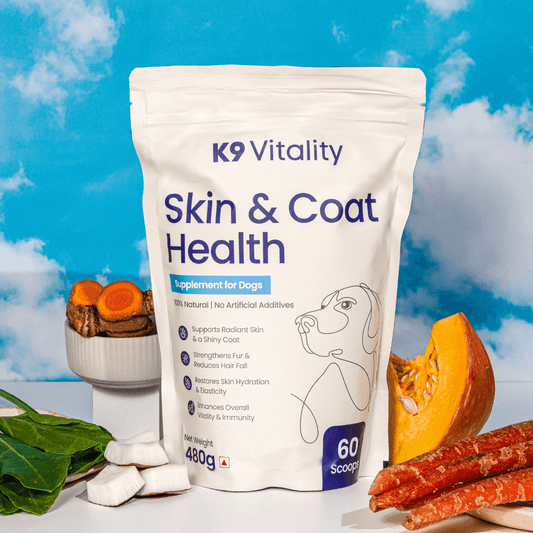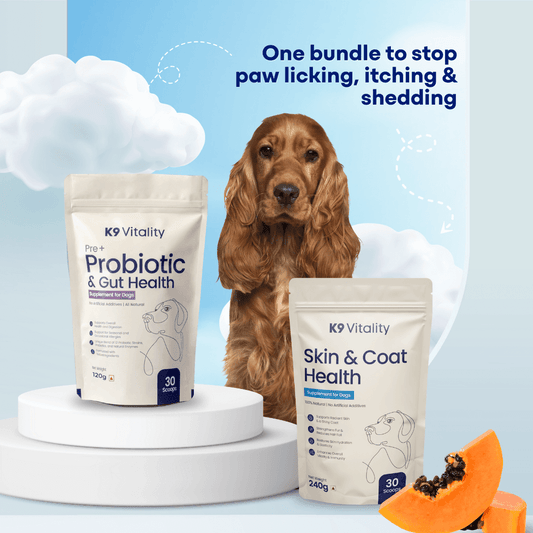
The Ultimate Guide to Hydration and Electrolytes for Active Dogs
Share
Have you ever watched your dog bound through the grass and wondered what really fuels their energy? While we often focus on food, hydration and electrolytes are the unsung heroes behind every joyful leap and tireless sprint. In this guide, we won’t just scratch the surface—we’ll dive deep into the science of canine fluid balance, exploring exactly how water and charged minerals keep your pup happy, healthy, and performing at their peak.
From understanding why dogs lose fluids differently than humans, to decoding the roles of sodium, potassium, and more, K9 Vitality is your trusted companion. Whether you’re prepping for an agility trial, planning a summer hike, or simply ensuring everyday wellness, this introduction will equip you with the insights and tools you need. Let’s turn knowledge into action and keep tails wagging with optimal hydration!
1. Why Hydration Matters: The Canine Perspective
Dogs maintain body temperature primarily through panting, not sweating. While panting cools them down, it does not expel significant electrolytes like human perspiration does—yet fluid loss still occurs. Key reasons why optimal hydration matters:
- Thermoregulation: Prevents heat stroke on hot days.
- Cellular Function: Water makes up about 60–70% of a dog’s body; it’s crucial for nutrient transport and waste removal.
- Joint Health: Synovial fluid in joints relies on hydration to maintain cushioning and mobility.
- Digestion & Metabolism: Aids in nutrient absorption and energy production.
2. Understanding Electrolytes: The Essential Players

Electrolytes are minerals that carry an electric charge in bodily fluids. They regulate nerve impulses, muscle contractions, acid-base balance, and fluid distribution between compartments. The most important electrolytes for dogs include:
- Sodium (Na⁺) – Controls fluid volume and nerve function.
- Potassium (K⁺) – Critical for muscle contraction and cardiac rhythm.
- Chloride (Cl⁻) – Works with sodium to maintain water balance.
- Magnesium (Mg²⁺) – Supports muscle relaxation, enzyme activity.
- Calcium (Ca²⁺) – Essential for bone health and muscle signaling.
While a balanced diet provides baseline electrolytes, active or ill dogs may require targeted supplementation to replace losses from panting, vomiting, or diarrhea.
3. Signs of Dehydration and Electrolyte Imbalance
Keeping a close eye on your dog’s behavior and physical signs can help you intervene early:
- Dry, sticky gums
- Loss of skin elasticity (pinch-and-see test)
- Lethargy or excessive panting
- Sunken eyes
- Reduced urination
- Muscle weakness or cramping
Tip: Perform the pinch test by gently lifting the skin at the scruff: if it doesn’t snap back immediately, hydration levels may be low.
4. Daily Hydration Strategies for Dog Parents

Keeping water fresh, accessible, and appealing is the first line of defense:
- Multiple Water Stations: Place bowls indoors and outdoors; elevate bowls for large breeds.
- Running Water: Many dogs prefer fountains—consider a canine-friendly water fountain.
- Flavor Boosts: Add a splash of low-sodium bone broth to entice reluctant drinkers.
- Moisture-Rich Foods: Incorporate wet/canned food or raw diets to up water intake naturally.
5. Electrolyte Supplementation: When and How
When to Supplement
- High-Intensity Activity: Agility, long hikes, or endurance events.
- Heat Exposure: Summer months or tropical climates.
- Illness: Vomiting, diarrhea, or post-surgical recovery.
Choosing the Right Product
- Balanced Formulations: Look for canine-specific supplements with ideal Na:K ratios.
- Forms Available: Powders, liquids, chews—choose based on ease of administration.
- Avoid Over-Supplementation: Excessive electrolytes can cause GI upset.
DIY Electrolyte Solution Recipe
- 1 L of filtered water
- ¼ tsp salt (sodium chloride)
- ¼ tsp baking soda (sodium bicarbonate)
- 1 tbsp unsweetened coconut water
- Optional: 1 tsp raw honey
Mix thoroughly; offer in small, frequent amounts to prevent GI distress.
6. Pre- and Post-Exercise Hydration Protocols
| Timing | Protocol |
|---|---|
| Pre-Work | Offer electrolyte-enhanced water 30 min before activity. |
| During | Provide small sips every 15–20 min; avoid puddles or deep bowls. |
| Post-Work | Within 10 min, give regular water + electrolyte solution to aid recovery. |
Note: Avoid forcing large volumes at once—aim for steady intake.
7. Special Situations: Travel, Competition, and Senior Dogs
- Travel: Carry portable water bottles and collapsible bowls; pre-mix electrolyte solution in sealed bottles.
- Competition: Coordinate with veterinarians or canine nutritionists to tailor hydration plans.
- Senior Dogs: Reduced thirst response and kidney function may necessitate more frequent hydration breaks and gentle electrolyte support.
8. Monitoring and Veterinary Consultation
Even the best plan requires oversight:
- Home Checks: Daily skin-pinch test, gum moisture, and appetite observation.
- Urine Color Chart: Pale straw color indicates good hydration; dark yellow signals concern.
- Vet Visits: If dehydration signs persist beyond 12 hours, seek professional evaluation for IV fluids or further diagnostics.
9. Frequently Asked Questions (FAQs)
Q: How much water should my dog drink daily?
A: A general guideline is 1 ounce per pound of body weight (30 ml per kg), adjusted for activity, diet moisture, and environmental temperature.
Q: Can I give my dog sports drinks like Gatorade?
A: Occasional, diluted small amounts aren’t harmful, but human formulations often contain sugars and additives unsuitable for long-term use.
Q: What if my dog refuses the electrolyte solution?
A: Try flavoring with unsalted bone broth, low-sugar fruit purees (e.g., apple), or switching to chewable electrolyte treats designed for canines.
Conclusion
Ensuring your dog stays properly hydrated and balanced in electrolytes is more than a routine—it’s a commitment to their wellbeing and the key to unlocking their best performance and longevity. As you’ve learned, small changes in water strategies and targeted electrolyte support can produce remarkable results, from preventing heat stress to speeding recovery after play.
K9 Vitality stands by you with practical tips, reliable supplements, and DIY solutions tailored for every stage of your dog’s life. Start implementing these strategies today:
- Audit and optimize your dog’s daily water intake.
- Integrate electrolyte boosts around high-intensity activities.
- Monitor key signs and consult your vet proactively.
Your dog’s vitality is in your hands—embrace these hydration principles, and witness the transformative power of proper fluid and mineral balance. Here’s to healthier, happier adventures together!






